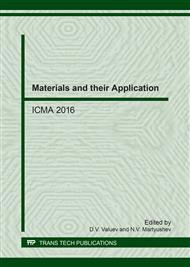[1]
S.W. Chunga, K. Higashia, W.J. Kim, Superplastic gas pressure forming of fine-grained AZ61 magnesium alloy sheet. J. Materials Science and Engineering: A. 372 (2004) 15–20.
DOI: 10.1016/j.msea.2003.08.125
Google Scholar
[2]
Alwin Schulza, Volker Uhlenwinkela, Christoph Escherb, Rainer Kohlmannc, Alfred Kulmburgd, Maria Carmen Monteroe, Roland Rabitschf, Wolfgang Schützenhöferf, Domenico Stocchig. Opportunities and challenges of spray forming high-alloyed steels. Materials Science and Engineering. 477 (2008).
Google Scholar
[3]
J. Michael, O'Briena, F. von Bremenb Hubertus, Minoru Furukawac, Zenji Horitad. A finite element analysis of the superplastic forming of an aluminum alloy processed by ECAP. J. Materials Science and Engineering: 456 (2007) 236–242.
DOI: 10.1016/j.msea.2006.11.116
Google Scholar
[4]
K.C. Chana, G.F. Wanga, C.L. Wanga and K.F. Zhang. Low temperature superplastic gas pressure forming of electrodeposited Ni/SiCp nanocomposites. J. Materials Science and Engineering. 404 (2005) 108–116.
DOI: 10.1016/j.msea.2005.05.042
Google Scholar
[5]
S.P. Yakovlev, V.N. Chudin, S.S. Yakovlev, Ya.A. Sobolev, Isothermal Straining of High-Strength Anisotropic Materials. Mashinostroyenie. (2004) 427.
Google Scholar
[6]
S.P. Yakovlev, V.N. Chudin, Ya.A. Sobolev, S.S. Yakovlev, V.I. Tregubov, S.N. Larin, Isothermal Pneumatic Moulding of Anisotropic High-Strength Sheet Materials. Mashinostroyenie. (2009) 352.
Google Scholar
[7]
S.P. Yakovlev, S.S. Yakovlev, V.A. Andreichenko, Processing Anisotropic Materials with Pressure. Kishinev. Quant. (1997) 332.
Google Scholar
[8]
F.V. Grechnikov, Deformation of Anisotropic Materials. M. Mashinostroyenie. (1998) 446.
Google Scholar
[9]
S.S. Yakovlev, V.D. Kukhar, V.I. Tregubov, Theory and Technology of Stamping Anisotropic Materials. Mashinostroyenie. (2012) 400.
Google Scholar
[10]
V.A. Golenkov, S.P. Yakovlev, S.A. Golovin, S.S. Yakovlev, V.D. Kukhar, Theory of Metal Processing with Pressure. University text-book. (2009) 442.
Google Scholar
[11]
Wenjun Zhao, Fuyang Cao, Xiaolong Gu, Zhiliang Ning, Ying Han, Jianfei Sun. Isothermal straining of spray formed Al–Zn–Mg–Cu alloy. Mechanics of Materials. 56 (2013) 95–105.
DOI: 10.1016/j.mechmat.2012.09.009
Google Scholar
[12]
S. Rusz, J. Sinczak and W. Lapkowski, 1997. Isothermal plastic forming of high-carbon steel. Materials Science and Engineering. 234–236 (2013) 430-433.
DOI: 10.1016/s0921-5093(97)00155-x
Google Scholar
[13]
J. Sinczak, W. Lapkowski, S. Rusz, Isothermal plastic forming of high melting temperature alloys. Journal of Materials Processing Technology. 72 (1997) 429-433.
DOI: 10.1016/s0924-0136(97)00206-9
Google Scholar
[14]
I. Puertas, C.J. Luis-Pérez, D. Salcedo, J. León, R. Luri, J.P. Fuertes, Isothermal Upset Forging of AA5083 after Severe Plastic Deformation by ECAE. Procedia CIRP. 12 (2013) 288–293.
DOI: 10.1016/j.procir.2013.09.050
Google Scholar
[15]
Wan-peng DONG, CHEN3D FEA Jun. Simulation of 4A11 piston skirt isothermal forging process. Transactions of Nonferrous Metals Society of China. 18 (2008) 1196–1200.
DOI: 10.1016/s1003-6326(08)60204-6
Google Scholar
[16]
M. Abbasia, A. Saeed-Akbarib, M. Naderi, The effect of strain rate and deformation temperature on the characteristics of isothermally hot compressed boron-alloyed steel. J. Materials Science and Engineering. 538. (2012) 356–363.
DOI: 10.1016/j.msea.2012.01.060
Google Scholar
[17]
M. Naderia, L. Durrenbergerb, A. Molinarib, W. Blecka Constitutive relationships for 22MnB5 boron steel deformed isothermally at high temperatures. J. Materials Science and Engineering. 478 (2008) 130–139.
DOI: 10.1016/j.msea.2007.05.094
Google Scholar
[18]
Fuxiaoa Yu, Jianzhonga Cui, Ranganathanb S., Dwarakadasab E.S. Fundamental differences between spray forming and other semisolid processes. J. Materials Science and Engineering. 304–306 (2010) 621–626.
DOI: 10.1016/s0921-5093(00)01547-1
Google Scholar
[19]
Li Lia, Xinming Zhangb. Hot compression deformation behavior and processing parameters of a cast Mg–Gd–Y–Zr alloy. J. Materials Science and Engineering. 528 (2011) 1396–1401.
DOI: 10.1016/j.msea.2010.10.026
Google Scholar
[20]
Eva-Lis Odenbergera Thermo-mechanical material response and hot sheet metal forming of Ti-6242. J. Materials Science and Engineering. 489 (2008) 158–168.
DOI: 10.1016/j.msea.2007.12.047
Google Scholar


